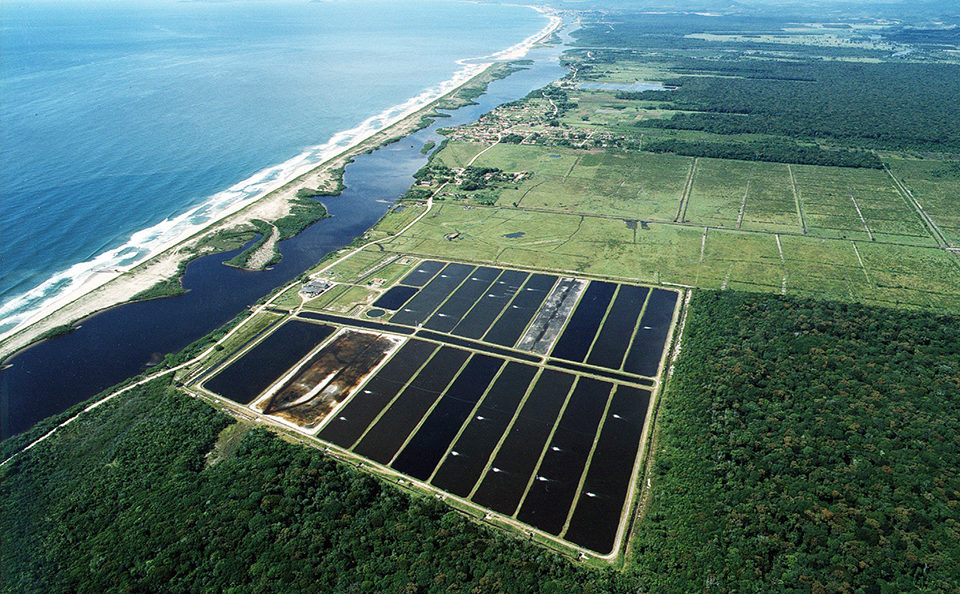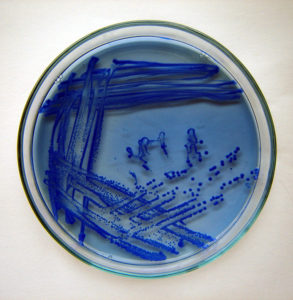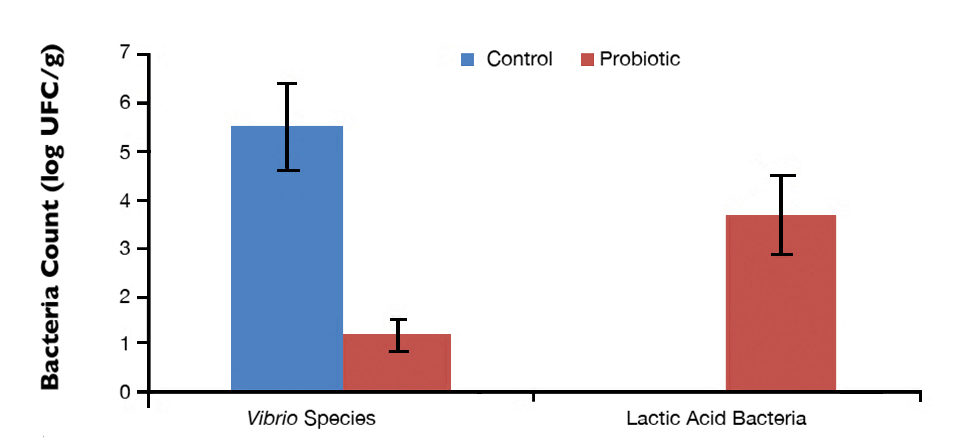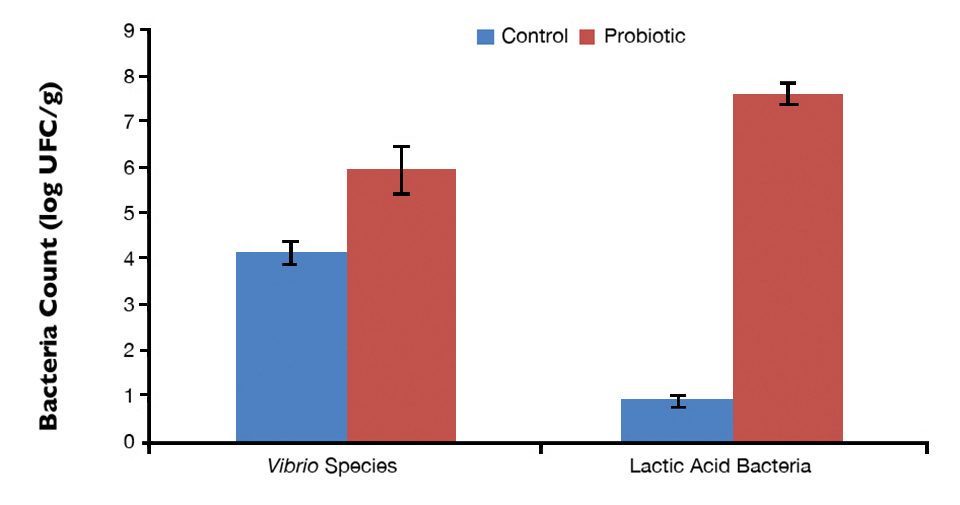Shrimp fed diet supplemented with probiotics had higher survival, lower FCR

Most people on this vast planet do not realize that microorganisms represent the majority of the Earth’s inhabitants in number, biomass and genetic diversity. Among this immense world of microorganisms, the development of a specific probiotic for use in aquaculture is an arduous task that includes the isolation of microorganisms, selection according to in vitro characteristics and trials on pilot and commercial scales.
With financial support from the Brazilian Ministry of Fishing and Aquaculture (MPA), Financing Agency for Studies and Projects (FINEP), and Scientific and Technological Research Support Foundation of Santa Catarina (FAPESC), the authors conducted studies at the Universidade Federal de Santa Catarina in Brazil to develop a probiotic for marine shrimp cultivation.
Isolation of bacteria strains
The isolation of bacteria from the intestinal tract of the animal in study is the first step toward successful development of a probiotic. Selective and differentiating culture mediums are used to isolate specific groups of beneficial bacteria. In this case, the authors sought to isolate lactic acid bacteria because they have beneficial characteristics such as easy multiplication, the production of compounds that inhibit pathogenic bacteria (hydrogen peroxide, organic acids and bacteriocins), and production of exogenous enzymes and immunostimulant compounds.
To isolate the strains, a de Man, Rogosa and Sharpe medium with aniline blue indicator was used, so the lactic acid bacteria colonies were colored blue. In this step, 78 strains of lactic acid bacteria were isolated from the intestinal tracts of Litopenaeus vannamei shrimp cultivated in a super-intensive biofloc system.
In vitro strain selection

The high number of the bacterial strains isolated made direct evaluation of the effects of each strain on the animals in cultivation difficult. Various in vitro laboratory selection tests were thus conducted to select a few strains to test with the animals. For the selection used in this study, the following characteristics were considered.
Inhibition of pathogens. Evaluation of the capacity of the isolated strains to inhibit the growth of pathogenic bacteria for marine shrimp by means of the diameter of the inhibition zone (Kirby-Bauer technique in diffusion in agar).
Growth kinetics. Growth velocity is an important characteristic, as high growth speed permits more efficient commercial production processes and can indicate greater competitiveness of the strain in the environment.
Resistance to different salinities. In marine shrimp cultivation, variations in salinity depend on the region, time of year and rainfall, and can range from close to zero to higher than that of the ocean in very saline regions. It is therefore important for commercial probiotic bacteria to survive wide variations in salinity.
Resistance to different pH values. Since the pH of water used for cultivation is not constant and can vary from close to 6 in super-intensive shrimp cultivation with biofloc up to 9 in eutrophic ponds, probiotic strains must handle a broad pH range.
Resistance to biliary salts. Biliary salts have an emulsifying function, increasing the solubility of fats and fat-soluble vitamins to help in their absorption. This detergent effect is microbicidal because it can affect the phospholipids and fatty acids on the walls of the microorganisms. For a probiotic to efficiently colonize an animal’s digestive tract, it is important for it to resist the action of biliary salts.
From these in vitro tests, a theoretically ideal strain based on the best results obtained from the evaluated strains was defined. The ideotype had the highest growth velocity, greatest capacity to inhibit pathogens and greater capacity to resist biliary salts, different pH values and salinities. Lactobacillus plantarum was selected for later studies.
Probiotic in shrimp hatchery
The colonization of the digestive tract of shrimp larvae by beneficial bacteria can be an important strategy for the prevention of infirmities. The larvae are only totally colonized in the digestive tract when there is a transformation to the protozoea state with the initiation of exogenous feeding. Thus, the supply of a diet supplement with probiotics in this stage can lead to the establishment of a favorable intestinal bacterial microbiota from the beginning.
In an experimental hatchery, it was observed that from the nauplius V stage to postlarva 1, diet supplementation with L. plantarum increased the survival of the larva, with survival rates of 51 percent for those in the probiotic treatment and 21 percent for the control group. There was also a modification in the bacterial microbiota of the larvae, with an increase in the concentration of beneficial bacteria (lactic acid) and decrease in the population of Vibrio species (Fig. 1). Larvae fed with L. plantarum had even greater resistance to an experimental challenge with V. harveyi, with 80 percent survival in relation to 50 percent survival in the control group.

Probiotic in experimental cultivation
In this study, experimental cultivation was conducted in clearwater for 60 days, beginning with the shrimp in the post-larvae 20 stage. A modification in
the intestinal bacterial microbiota was observed, with a decrease in the population of Vibrio species and an increase of lactic acid bacteria (Fig. 2) in the shrimp fed with probiotics.

However, there was no alteration in the survival rate (81 percent) and final average weight (6 grams) in both treatments. These results were expected, given that the shrimp were maintained under excellent cultivation conditions with 70 percent daily water exchange and a temperature of 30 degrees-C during the experiment.
At the end of cultivation, the shrimp were challenged with V. harveyi by intramuscular injection. After 12 hours, it was observed that the shrimp fed with probiotics had a 66 percent survival rate compared to the control animals’ 40 percent survival.
Probiotic at shrimp farm
Studies conducted in controlled laboratory conditions are important, but their results are not always replicated on a commercial scale. Thus, in the final step of this work, the use of L. plantarum was evaluated under commercial conditions at the Universidade Federal de Santa Catarina Yakult Experimental Farm. Six, 12,000-m2 ponds stocked at 14 shrimp/m2 were used. The shrimp in three ponds received a diet supplemented with probiotics and three were maintained as a control.
After 75 days of cultivation, the shrimp whose diet was supplemented with probiotics had a higher survival rate and lower feed-conversion rate (Table 1), with no alteration in their growth rate. This result should be associated with a change in the intestinal bacterial microbiota of the shrimp fed with probiotics. The decrease in the Vibrio populations in the animals’ intestines led to the increased survival of the shrimp in the ponds fed with probiotics.
Meanwhile, the lower feed conversion can be related to the capacity of the probiotic bacteria to stimulate the production of digestive enzymes in the host, improving the digestibility of the rations. A study conducted for a master’s dissertation by Celso Buglione-Neto demonstrated that the addition of L. plantarum to the diet of shrimp improves the apparent digestibility of the protein in the ration, corroborating the authors’ hypothesis.
(Editor’s Note: This article was originally published in the November/December 2011 print edition of the Global Aquaculture Advocate.)
Authors
-
Dr. Felipe do Nascimento Vieira
Universidade Federal de Santa Catarina
Departamento de Aquicultura
Laboratório de Camarões Marinhos
Ademar Gonzaga Street, 1346
Florianópolis, Santa Catarina, Brazil[114,98,46,99,115,102,117,46,109,99,108,64,110,102,97,114,105,101,105,118]
-
Dr. José Luis Mouriño
Universidade Federal de Santa Catarina
Departamento de Aquicultura
Laboratório de Camarões Marinhos
Ademar Gonzaga Street, 1346
Florianópolis, Santa Catarina, Brazil -
Bruno Correa da Silva, M.S.
Universidade Federal de Santa Catarina
Departamento de Aquicultura
Laboratório de Camarões Marinhos
Ademar Gonzaga Street, 1346
Florianópolis, Santa Catarina, Brazil -
Dr. Walter Quadros Seiffert
Universidade Federal de Santa Catarina
Departamento de Aquicultura
Laboratório de Camarões Marinhos
Ademar Gonzaga Street, 1346
Florianópolis, Santa Catarina, Brazil -
Dr. Luis Alejandro Vinatea
Universidade Federal de Santa Catarina
Departamento de Aquicultura
Laboratório de Camarões Marinhos
Ademar Gonzaga Street, 1346
Florianópolis, Santa Catarina, Brazil
Tagged With
Related Posts

Health & Welfare
A holistic management approach to EMS
Early Mortality Syndrome has devastated farmed shrimp in Asia and Latin America. With better understanding of the pathogen and the development and improvement of novel strategies, shrimp farmers are now able to better manage the disease.

Responsibility
A look at integrated multi-trophic aquaculture
In integrated multi-trophic aquaculture, farmers combine the cultivation of fed species such as finfish or shrimp with extractive seaweeds, aquatic plants and shellfish and other invertebrates that recapture organic and inorganic particulate nutrients for their growth.

Aquafeeds
A look at phospholipids in aquafeeds
Phospholipids are the major constituents of cell membranes and are vital to the normal function of every cell and organ. The inclusion of phospholipids in aquafeeds ensures increased growth, better survival and stress resistance, and prevention of skeletal deformities of larval and juvenile stages of fish and shellfish species.

Aquafeeds
A look at protease enzymes in crustacean nutrition
Food digestion involves digestive enzymes to break down polymeric macromolecules and facilitate nutrient absorption. Enzyme supplementation in aquafeeds is a major alternative to improve feed quality and nutrient digestibility, gut health, compensate digestive enzymes when needed, and may also improve immune responses.


